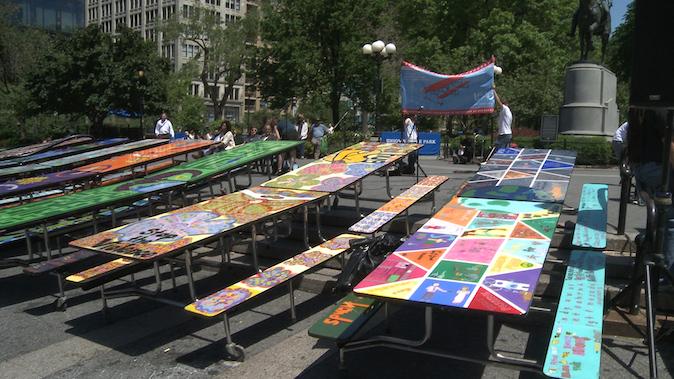NEW YORK—“Crack is wack.” “Don’t drink and drive.” “I promise not to bully.” These were some of the phrases found on artistic lunch tables on display in Union Square Park.
On Tuesday, the nonprofit Learning through an Expanded Arts Program, or LEAP, kicked off its 7th annual student art exhibit in the park. Each year, it reaches out to 10 schools in New York City—two in each borough—to have students explore social issues in their community through the visual arts.
LEAP brings teaching artists together with students to paint lunch tables and make them into murals with a message, one table for each school. The students worked on the tables over a period of two months, each with a different theme close to their hearts.
“We’ve always used school lunchroom tables as a canvas. For us, the idea is that kids are in the cafeteria and that’s where they’re talking about issues. So to use that as a symbol and to bring that out to a park setting is the point of the program—to really illuminate the issues and to be a catalyst for social change through art,” explained Alexandra Leff, one of the organizers of the exhibit.
Addressing Bullying
At Global Leaders Middle School, 30 students transformed a lunch table into a board game that doubles as an anti-bullying educational device. The players draw cards that ask questions such as “have you ever bullied someone,” and “have you ever helped a friend who had been bullied,” with the card telling you to go two steps back and two steps forward respectively.
Minnie, a student at Global Leaders, said that her class chose this topic because, “Everyone in my class has experienced bullying—either they were the bully, the victim, an upstander, a bystander, or even all of them.”
“Upstander” is the term for a bystander who reports the bully to a teacher and is featured in the board game Minnie and her peers made, where the player gets to move two steps ahead for being an upstander.
Angela Washington, another student at Global Leaders, said that the process of making the board game deepened her and her peers’ understanding of bullying. She thinks that this will lessen bullying at her school.
Social Change and Self-Expression
Speaking before a crowd at the exhibition, Brooklyn Parks Commissioner Kevin Jeffrey said: “Just like a table is a sort of canvas, life can be a canvas. Life can be a canvas, and in the same way you can change the way a table looks, you can also change your life and those around you through change.”
Virtually all the writings on the tables encouraged better behavior, addressing a multitude of problems ranging from students dropping out of school to teenage pregnancy. Yet, self-improvement was not the only purpose of the program, which also emphasizes self-expression among the students.
“Kids are part of our communities and they experience the same things as we do, they just don’t have a voice in the community. This project is a way to empower them to speak out on issues they’re most passionate about in a creative and instructive way,” Alexandra Leff said.
After the Tuesday exhibition, the tables will be distributed to locations near the schools where they were made, where they will double as actual lunch tables.






Friends Read Free